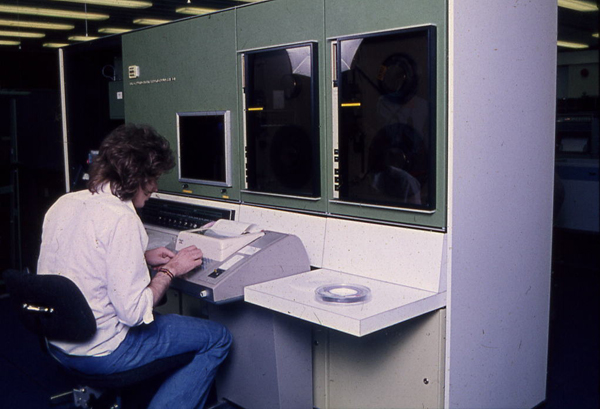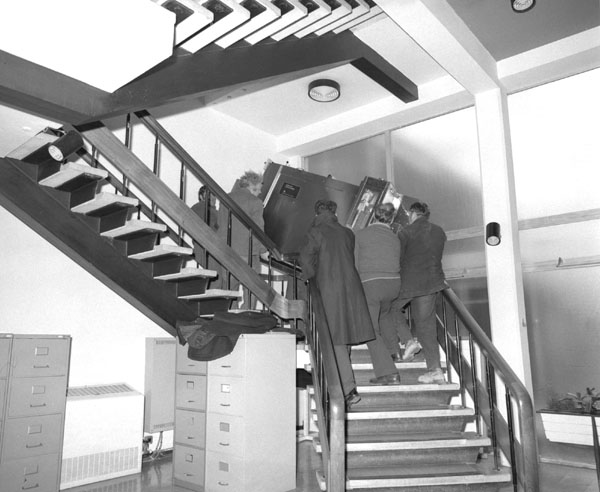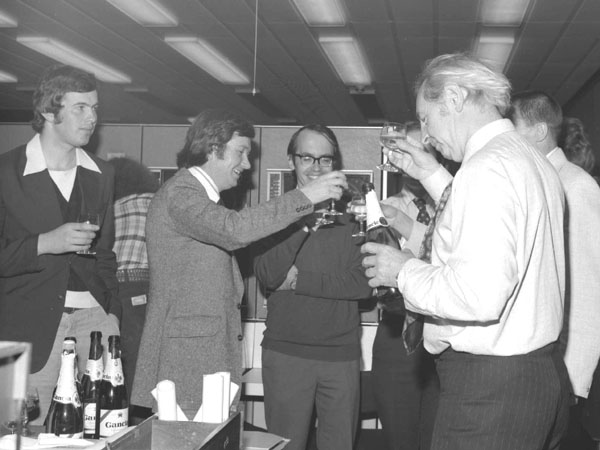


The FR80 magnetic tapes are to the right. The monitor screen is just in front of John Rushby. The camera bay is to his left.
The Atlas Laboratory has taken delivery recently of an FR 80 microfilm recorder to replace its SD 4020 which has been SRC's main graphical output device for the last seven years.
The attraction of a microfilm recorder for graphical output as against a pen-plotter is mainly its speed and flexibility. As well as being able to produce graphs on sensitized paper (called "hardcopy" for some unknown reason), the SD 4020 can output to both 16 mm and 35 mm film. In a typical year, the SD 4020 produces about 1,700,000 pages or frames, of output. We estimate that it would take about two hundred pen-plotters to generate a similar amount of output!
Users of Atlas' graphical facilities come from all parts of SRC. Probably the largest user of hardcopy is the Neutron Beam Research Unit at Chilton. Other large users include satellite data processing and the JASIN project organised by the Department of Oceanography at Southampton University. One of the more novel uses is, of course, the production of cine films. It is surprising how many of the large computer projects find this method of displaying results attractive. Films have been made on such diverse topics as galaxy evolution, effluent dispersal in the Solent and textile design.
The decision to replace the SD 4020 was made about three years ago. The machine is a mixture valve and solid state circuitry. It has become increasingly difficult to maintain and we have had to cannibalise two tape decks in order to keep the third one in a working condition. Even with a full-time engineer, the machine now only averages about 70% up-time in the prime shift.
The FR 80 microfilm recorder, manufactured by Information International Incorporated (111) of Los Angeles, was a natural successor to the SD 4020. It is both the most versatile and most accurate of the recorders currently available. Like the SD 4020, it has hardcopy, 16 mm and 35 mm cameras. In addition, it has a microfiche camera capable of producing fiche at a reduction of forty two or forty-eight times. This allows four hundred pages of output to be contained on a single fiche. With the world paper shortage, microfiche is becoming the standard interchange media for large volumes of text.
Our particular FR 80 has a number of recently introduced features which probably make it the most sophisticated recorder in the world today. A colour filter system incorporated in the 16 mm and 35 mm cameras allows multi-colour output to be produced directly on the recorder. Over two hundred distinct colours can be generated which gives the user another dimension to his output. This large range of colours is possible because two hundred and fifty-six different intensity levels can be produced.
Even though the order for the FR 80 was not placed until last October, III managed to deliver the machine before Easter - but not without some trials and tribulations on the way. Its journey to the Laboratory was delayed initially when it was found the contractors' truck sent to take the machine from the factory to the airport was not large enough, with the result that it missed the first plane out of Los Angeles.
Eventually, it arrived at the Atlas Computer Laboratory and there was a sigh of relief as it was successfully squeezed into the lift to take it to the first floor. The manufacturers' measurements had indicated that the machine was EXACTLY the same size as the lift so there was no room to spare - luckily, the only damage to paintwork was to the lift and not the FR 80!
Next came the film processor. This was obviously too large for the lift and the only way up was via three short flights of stairs, with a corner to negotiate at the end of each flight. However, several strong men made short work of this task and surprisingly quickly everything was in its place.
One minor hitch since installation has been that due to late delivery of a calorifier, one wing of the building is denied supplies of hot water whenever film processing is going on!

Some careful manoeuvring as the FR 80's film processor, weighing about 400 lbs, is taken up to the first floor
Hardware acceptance tests began as soon as the machine was installed while at the same time programmers were rapidly putting the finishing touches to some eight months' work rewriting the graphical software for both the 1906A and 360/195 computers so that it would work with the FR 80.
Early in May, the full range of acceptance tests were completed - not without some celebration - and user service introduced at the beginning of June.
Bob Hopgood is the Head of the Basic Software Group at Atlas.

Celebrating acceptance of the FR 80 are (from left to right Dave Daniel, Mike Daniels (of Information International Inc), Eric Thomas and Dr Howlett. In the background to the left is Alan Francis and behind Dr Howlett is Bob Hopgood.